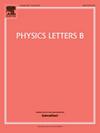Quantum detection of boundary conditions
IF 4.3
2区 物理与天体物理
Q1 ASTRONOMY & ASTROPHYSICS
引用次数: 0
Abstract
The quantum detection of spacetime conicity was investigated in reference Cong et al. (2021) [9] through the analysis of the response function of an Unruh-deWitt detector coupled to a massless scalar field. In particular, it was shown that the detector can discern the presence of the deficit angle of a region of spacetime even when it is placed on a flat region with no conical deficit and (due to the rapid switching on and off) is classically isolated from the conical region. The scalar field was supposed to be continuous at the three dimensional timelike hypersurface connecting both regions and it was argued that the non-trivial effects on the response function were only due to the deficit angle of the outer conical region. In this paper, we study the response function of the Unruh-deWitt detector on the same classical framework, but exploring the effects of the choice of boundary conditions for the scalar field at the connecting hypersurface. These boundary conditions are extracted from the two-interval Sturm-Liouville theory and each one gives rise to a physically inequivalent sensible dynamics for the quantum field. We show that they play an important role on the response function of the detector, which effectively “feels” the combined effect of conicity + boundary condition.
边界条件的量子探测
文献Cong et al.(2021)[9]通过分析耦合于无质量标量场的Unruh-deWitt探测器的响应函数,研究了时空锥度的量子探测。特别是,结果表明,即使探测器被放置在没有锥形赤字的平坦区域上,并且(由于快速开关)与锥形区域经典地隔离,探测器也可以识别时空区域的赤字角的存在。假设标量场在连接两个区域的三维类时超曲面上是连续的,并认为对响应函数的非平凡影响仅由外圆锥区域的亏角引起。本文研究了在同一经典框架下的Unruh-deWitt探测器的响应函数,但探讨了边界条件的选择对连接超曲面上标量场的影响。这些边界条件是从双区间Sturm-Liouville理论中提取出来的,每一个边界条件都会引起量子场的物理不等价的感动力学。结果表明,它们对探测器的响应函数起着重要的作用,探测器有效地“感受”到了锥度+边界条件的联合作用。
本文章由计算机程序翻译,如有差异,请以英文原文为准。
求助全文
约1分钟内获得全文
求助全文
来源期刊

Physics Letters B
物理-物理:综合
CiteScore
9.10
自引率
6.80%
发文量
647
审稿时长
3 months
期刊介绍:
Physics Letters B ensures the rapid publication of important new results in particle physics, nuclear physics and cosmology. Specialized editors are responsible for contributions in experimental nuclear physics, theoretical nuclear physics, experimental high-energy physics, theoretical high-energy physics, and astrophysics.
 求助内容:
求助内容: 应助结果提醒方式:
应助结果提醒方式:


